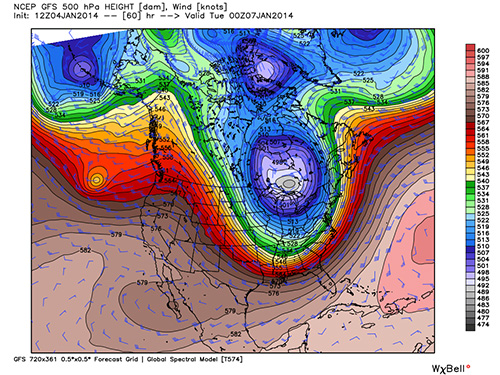This is the first video to include interviews conducted at the American Geophysical Union Fall Meeting in San Francisco in December 2013.
I started out with a focus on what we were hearing about extreme events, then took a little jog when the latest extreme even presented itself – our current polar vortex, which is a pretty good textbook example of the kind of weather that we may be seeing more of, paradoxically, in this case, cold snap made more likely by increasingly lazy jet stream flow.
The video above contrasts arctic cold and snow in the east with mild temps and droughts in California.
Complete report on drought from California TV station KSBW below.
Additional report now up on dry lakes in the California area.
Global warming may be contributing to the “polar vortex” causing frigid temperatures across most of the nation on Monday, according to some climate change researchers.
While it seems counter-intuitive, the research argues that plunging temperatures could come from changes in the jet stream caused by climate change.
Rutgers University climate scientist Jennifer A Francis has released a number of papers about changes in the jet stream brought about by warming Arctic temperatures.
Her conclusions suggest that warming Arctic air caused by greenhouse gas emissions has caused changing to the jet stream that is pushing colder Arctic air further south, causing temperatures to plunge from the High Plains to the Deep South.
The jet stream shift has sent frigid air across the central part of the country, and deeper into the south than normal.
Alaska, meanwhile, is being hit by unusually warm conditions and California is facing record-breaking drought, Francis said.
She said the strange weather is becoming more likely because of climate change.
“We can’t say that these are extremes are because of climate change but we can say that this kind of pattern is becoming more likely because of climate change,” Francis said.
NASA analysis has also drawn a link between the jet stream, climate change and colder temperatures.
A 2010 NASA analysis tied colder temperatures over the course of 2009 to an event similar to the wavy jet stream, called “Arctic oscillation” — a see-sawing pressure system over the North Pole. That oscillation pushed cold air to the south.
The NASA analysis also said that despite cold snaps, and other weather changes being a part of naturally occurring patterns, they are still in line with a “globally warming world.”
Almost half of the Lower 48 will shiver under sub-zero wind chills Tuesday morning. Countless records will be set. Yet none of that means a thing about the existence of climate change, its severity or its consequences.
The breaking off of a large chunk of the polar vortex and its visit to the northern U.S. is a random event resulting from a serendipitous arrangement of weather systems. In short, the clockwise flow around giant areas of high pressure over Alaska and west of Greenland have forced the atmosphere’s steering currents to shove the vortex into the northern U.S.
It happened before humans dumped billions of tons of carbon dioxide into the atmosphere and will happen again.
This polar vortex excursion is a single weather event directly affecting about 2% of the world.
Climate change is measured by evaluating continental to global trends in weather over decades – not events happening over a few days in a little region. For this reason, a fleeting cold wave (or snowstorm) over part of a continent should never be used as evidence for or against climate change.
The record shows winter temperatures have risen markedly in recent decades across the northern hemisphere.
In short, climate change has reduced the intensity/frequency of cold extremes averaged over time. But that doesn’t mean they’re over or have been eliminated. Events like the record cold in Europe in 2011 and this polar vortex event are clear examples of the exceptional cold weather extreme in a warming world.
(Were it not for the build-up of man-made greenhouse gases in the atmosphere, I’d posit the extreme cold events we witness now would be even colder. In other words, take these same cold air outbreaks and project them on the climate of the 1800s, and they’d be more severe. We’d need a model to test that, but it’s an educated guess.)
The truth is that increasing greenhouse gases act to warm the globe and, on average over time, should take an edge off the cold. But the planet is a really big, complicated place and the weather changes fast and randomly. Conversely, the climate changes very gradually. Taking all of this together, cold shouldn’t come as a shock, nor should it have anyone second-guessing the reality of climate warming.http://climatecrocks.com/2014/01/07/new-video-climate-jetstream-polar-vortex/










No comments:
Post a Comment